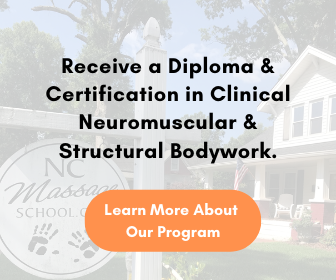Paying for Massage Therapy School
Pursuing a career in massage therapy is an exciting step toward a rewarding profession. Whether you’re enrolling in a certification program or taking continuing education courses to expand your skills, one of the biggest concerns for many students is how to afford your education.
The good news is that there are many ways to finance your massage therapy training, from scholarships and grants to employer assistance, flexible payment plans, and even tax credits. At NC Massage School, we want to help you explore all your options so that financial barriers don’t stand in the way of your passion.
Keep reading if you’ve been wondering how to afford massage therapy school. We’ve put together this guide to help you discover practical and realistic ways to fund your education without unnecessary financial stress.
Scholarships & Grants
One of the best ways to finance your massage therapy certification is through scholarships and grants, which do not have to be repaid. Many national and local organizations offer funding specifically for massage therapy students.
For example, the American Massage Therapy Association (AMTA) and the Massage Therapy Foundation provide scholarships for students who are passionate about the field. The Beauty Changes Lives Scholarship is another great opportunity for those entering the wellness and bodywork industry. If you live in North Carolina, you may also qualify for state-based tuition assistance through the NCSEAA (North Carolina State Education Assistance Authority).
Applying for scholarships takes effort, but the rewards can be worth it. Many require an application, a short essay, or letters of recommendation, so it’s important to start early and stay organized. Keep an eye on application deadlines, and highlight why you are passionate about massage therapy and how it aligns with your career goals.

Employer Tuition Assistance
Your employer may be able to help cover the cost of your massage therapy education, especially if you work in a spa, wellness center, medical office, or corporate wellness program. Many companies offer tuition reimbursement or professional development funds, even if they don’t advertise it.
Here’s how to explore your options:
- Check with HR or Your Manager – Ask if tuition assistance or training funds are available.
- Make a Strong Case – Show how your education will benefit the company, such as improving client services.
- Negotiate Alternatives – If full reimbursement isn’t offered, ask about partial funding, paid training hours, or schedule flexibility.
- Take Advantage of Tax Benefits – Under U.S. law, employers can provide up to $5,250 annually in tax-free tuition assistance.
Flexible Payment Plans
Paying for tuition all at once can be challenging, but thankfully, many massage therapy schools, including NC Massage School, offer flexible payment plans.
A payment plan allows you to break tuition into smaller, more manageable installments, reducing financial stress while you complete your training. Some schools even offer interest-free installment options to spread out payments without extra costs.
If you’re concerned about how you’ll afford school, contact our admissions team. We’re happy to discuss customized financing solutions that fit your needs.
529 College Savings Plans
If you or your family have a 529 college savings plan, you can use those funds to cover your massage therapy education.
Many people think 529 plans are only for traditional four-year colleges, but they can actually be used for vocational and career training programs, including massage therapy certification. If you already have a 529 plan set up for someone else, such as a child, you can change the beneficiary to yourself and use the funds tax-free for your tuition.
If you’re planning, opening a 529 savings account for yourself can be a tax-advantaged way to save for your future education.
Federal & State Financial Aid
Many students assume financial aid is only for college degrees, but some vocational programs, including massage therapy, may qualify. The Free Application for Federal Student Aid (FAFSA) is the best place to start, as it determines eligibility for grants, loans, and work-study programs.
If you’re changing careers or recently unemployed, you may also qualify for Workforce Innovation & Opportunity Act (WIOA) grants, which fund career training. Additionally, many states offer tuition assistance for vocational programs, so it’s worth checking what’s available in your area.
Other ways to reduce education costs include tax credits and deductions:
- Lifetime Learning Credit (LLC) – Claim up to $2,000 per year for tuition and education-related expenses.
- American Opportunity Credit (AOC) – A tax benefit for career training students.
- Education Expense Deductions – Some costs, like books, supplies, and licensing fees, may be tax-deductible.
Other Funding Options
If you still need help covering tuition after exploring scholarships, employer assistance, and payment plans, you may want to consider private student loans.
Federal Stafford Loans typically offer lower interest rates and flexible repayment plans, making them a better option than private loans if you qualify. However, if federal loans are not available for your program, some banks and credit unions offer private loans for career training. Just compare interest rates, repayment terms, and fees before borrowing.
Other creative ways to fund your education include crowdfunding platforms like GoFundMe or taking on a part-time job or gig work while in school. Some students find that working just a few extra hours per week can make a big difference in covering tuition costs.

Your Massage Therapy Education Is Within Reach
Financing your massage therapy education may feel overwhelming at first, but with the right approach, it’s possible.
You can make your training more affordable and manageable by exploring scholarships, employer assistance, flexible payment plans, tax benefits, and state grants. The key is to plan ahead, do your research, and take advantage of all available resources.
At NC Massage School, we’re here to help you every step of the way. If you have questions about tuition, payment options, or financial aid, contact us. We’ll work with you to find a solution that makes your dream of becoming a massage therapist a reality.


